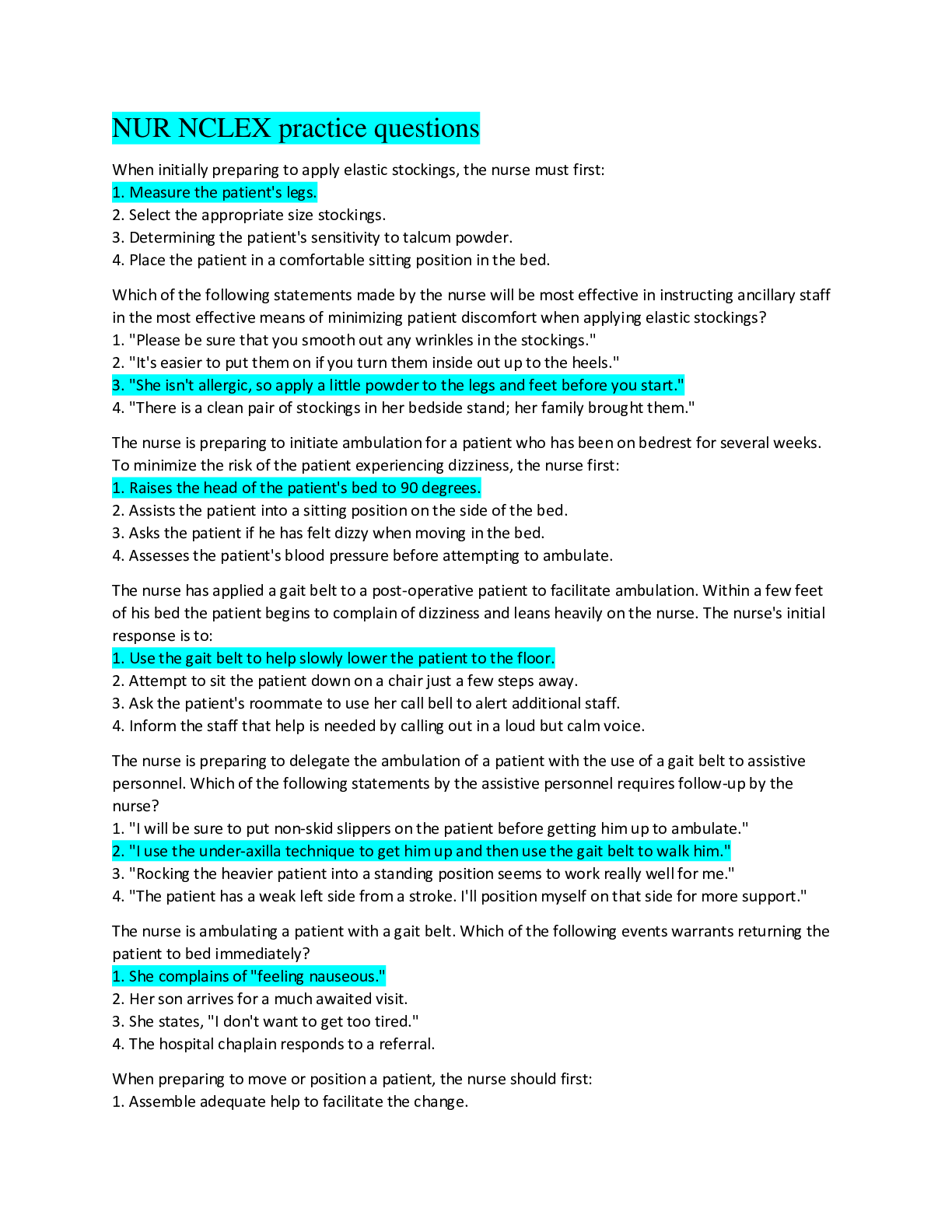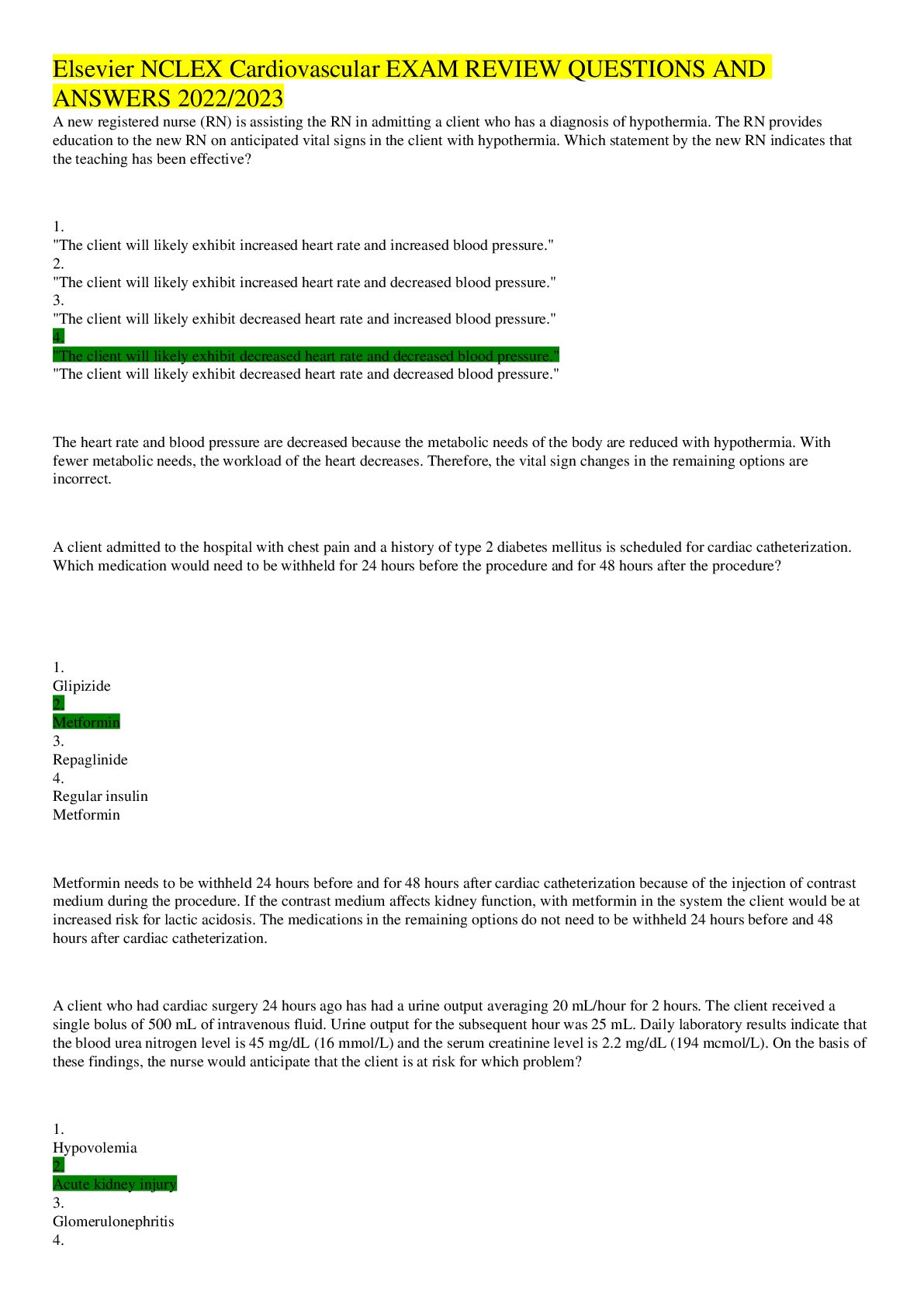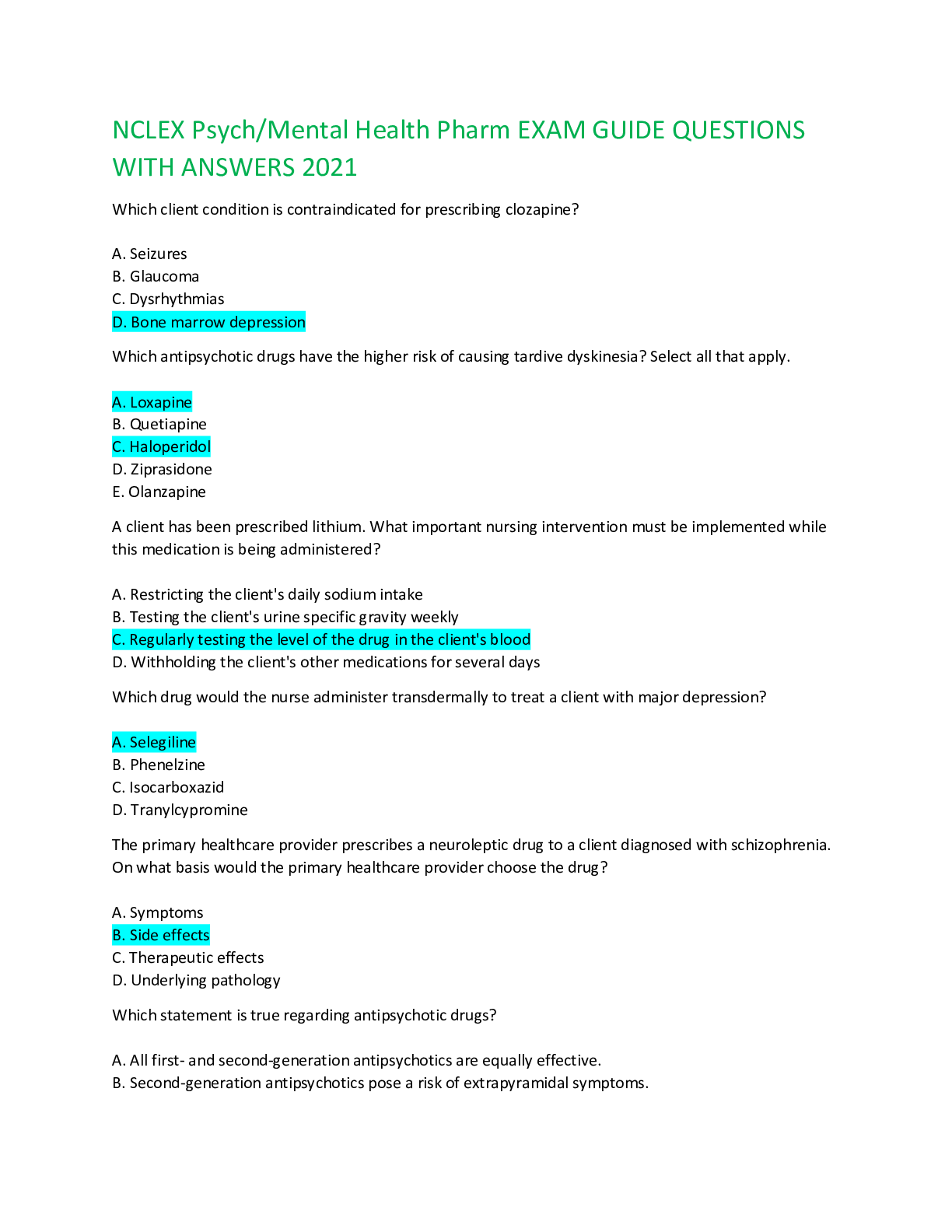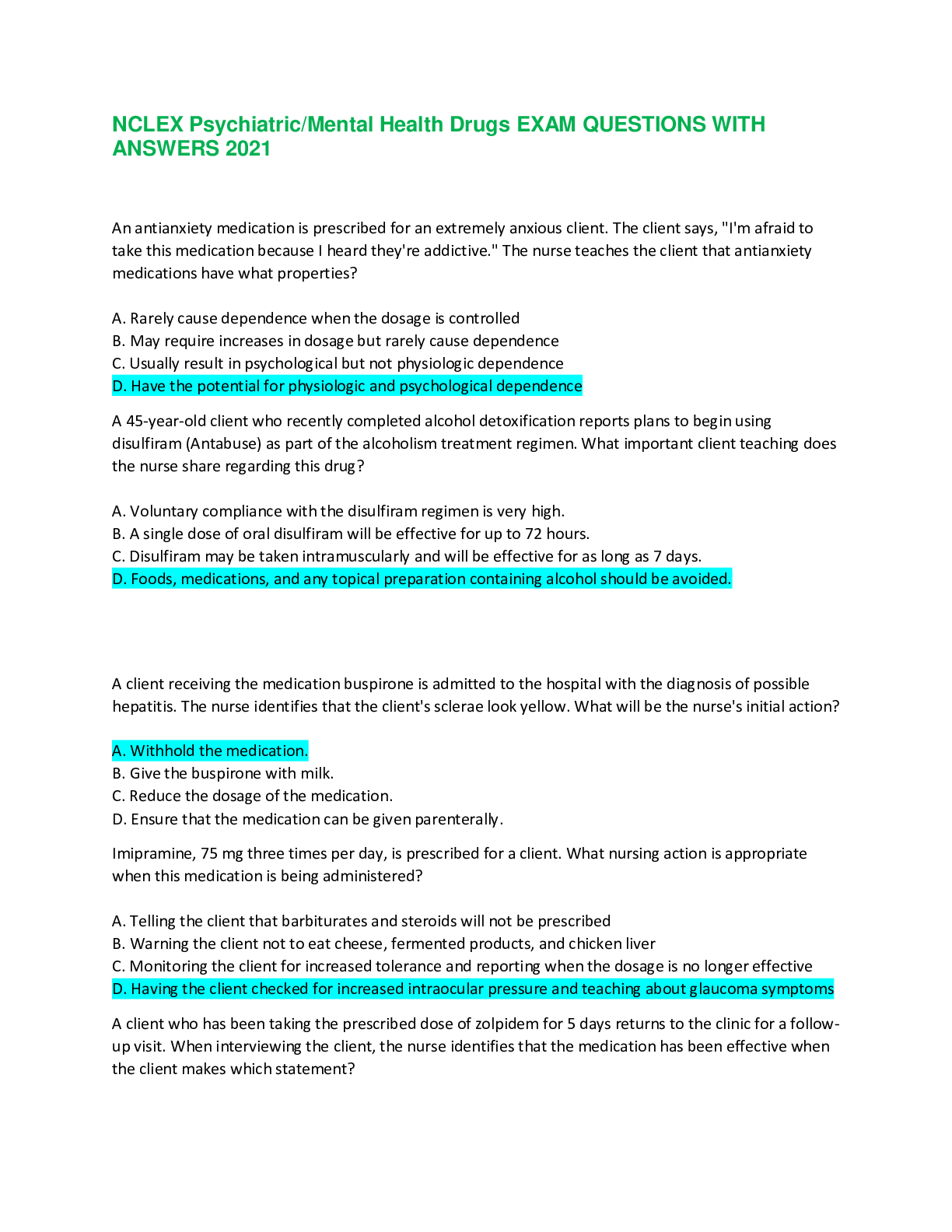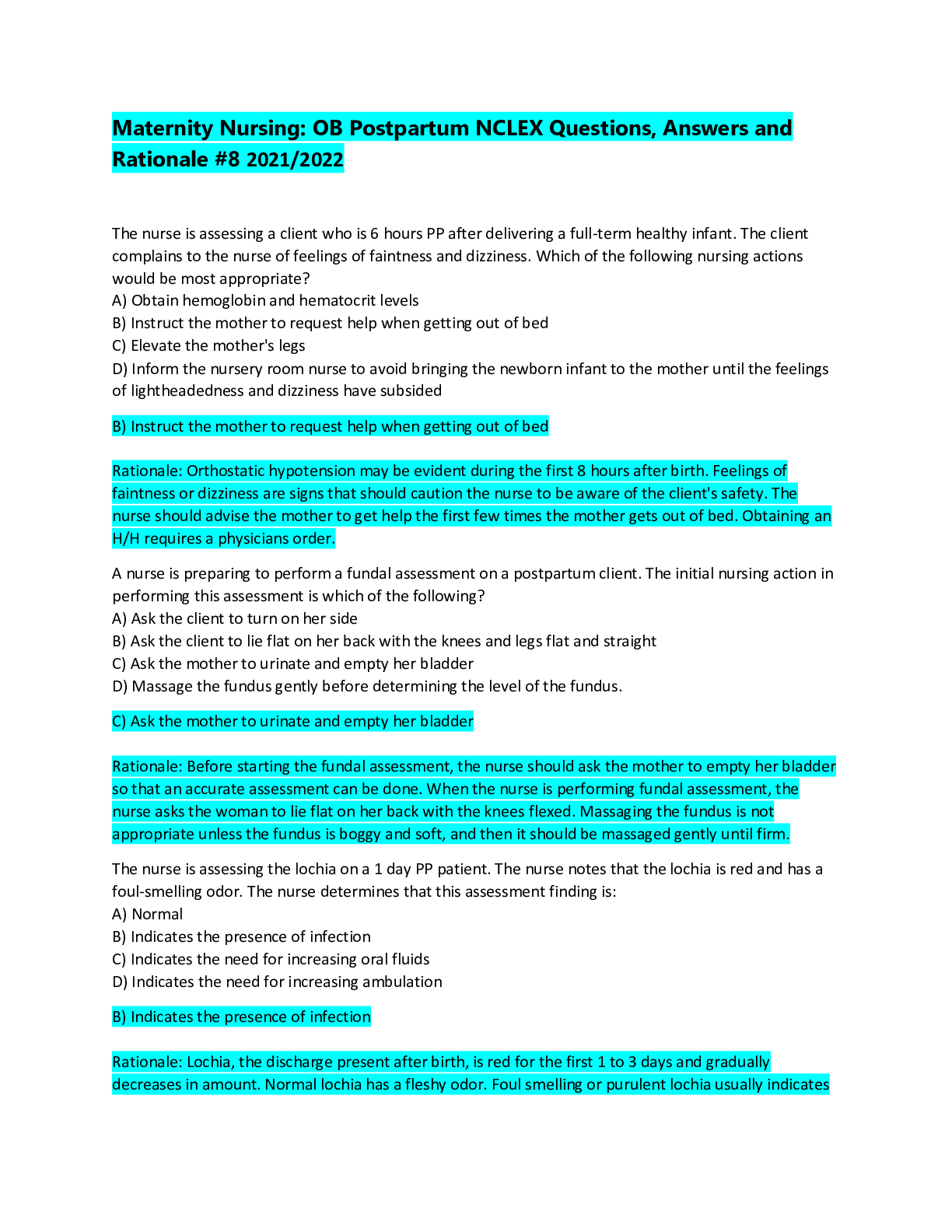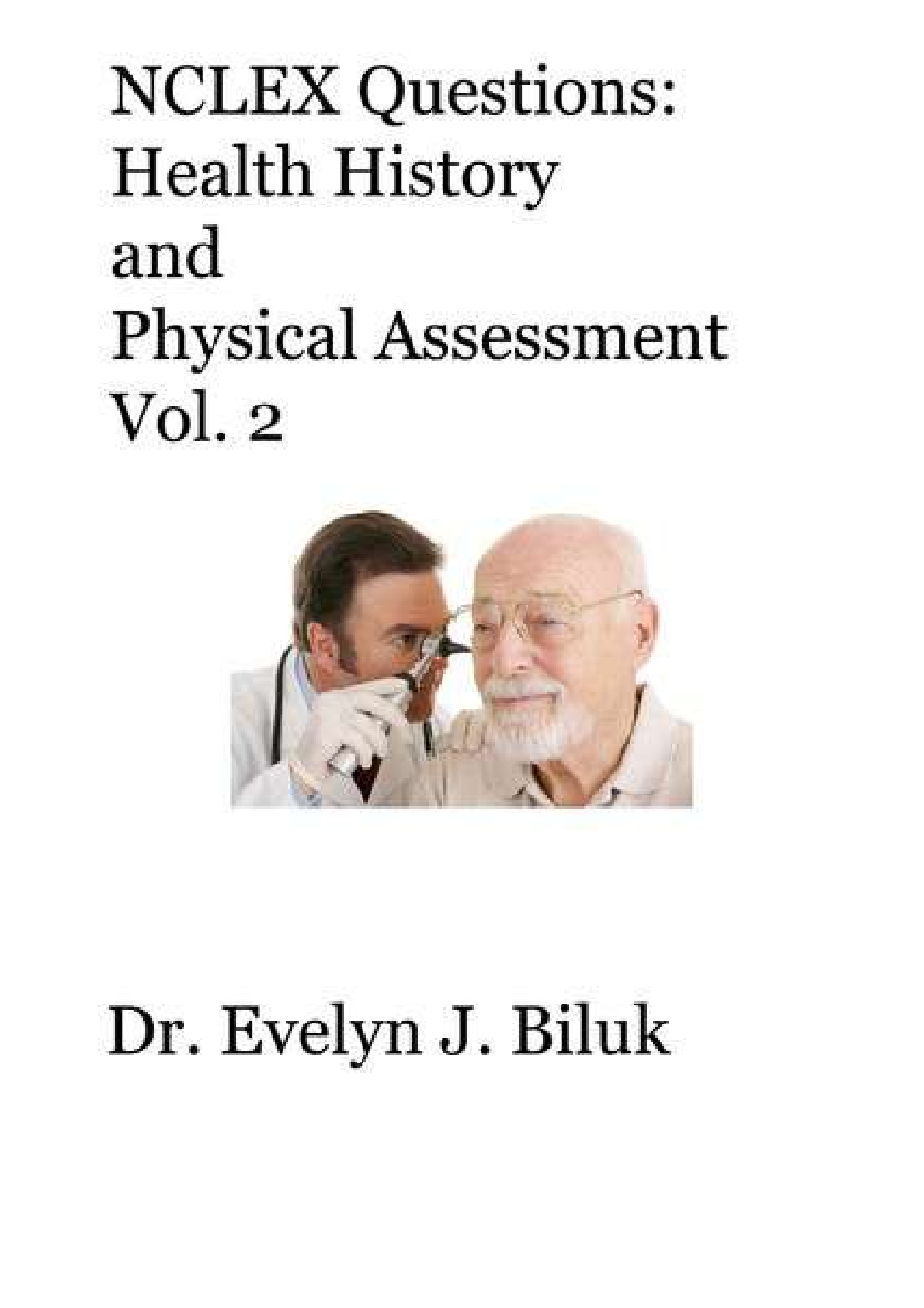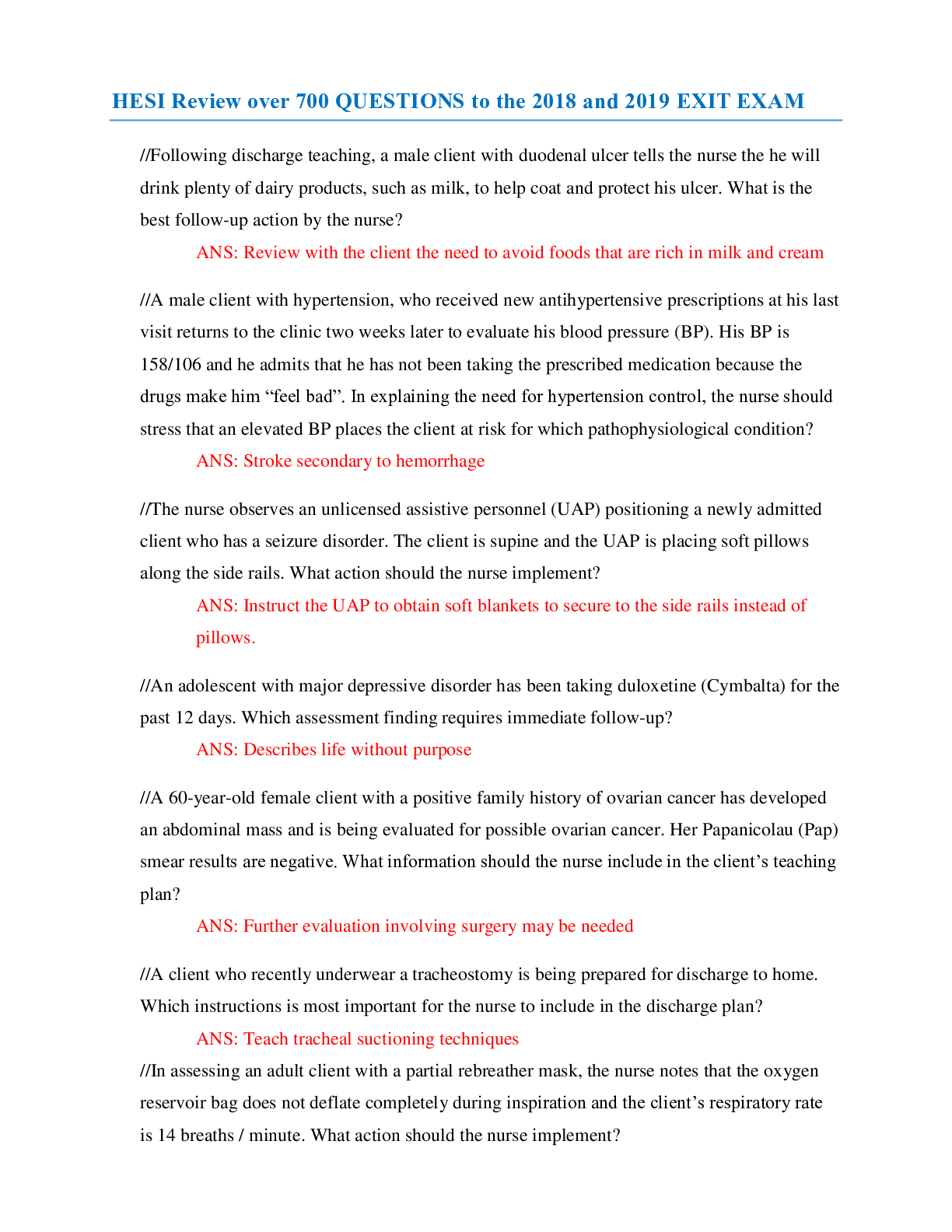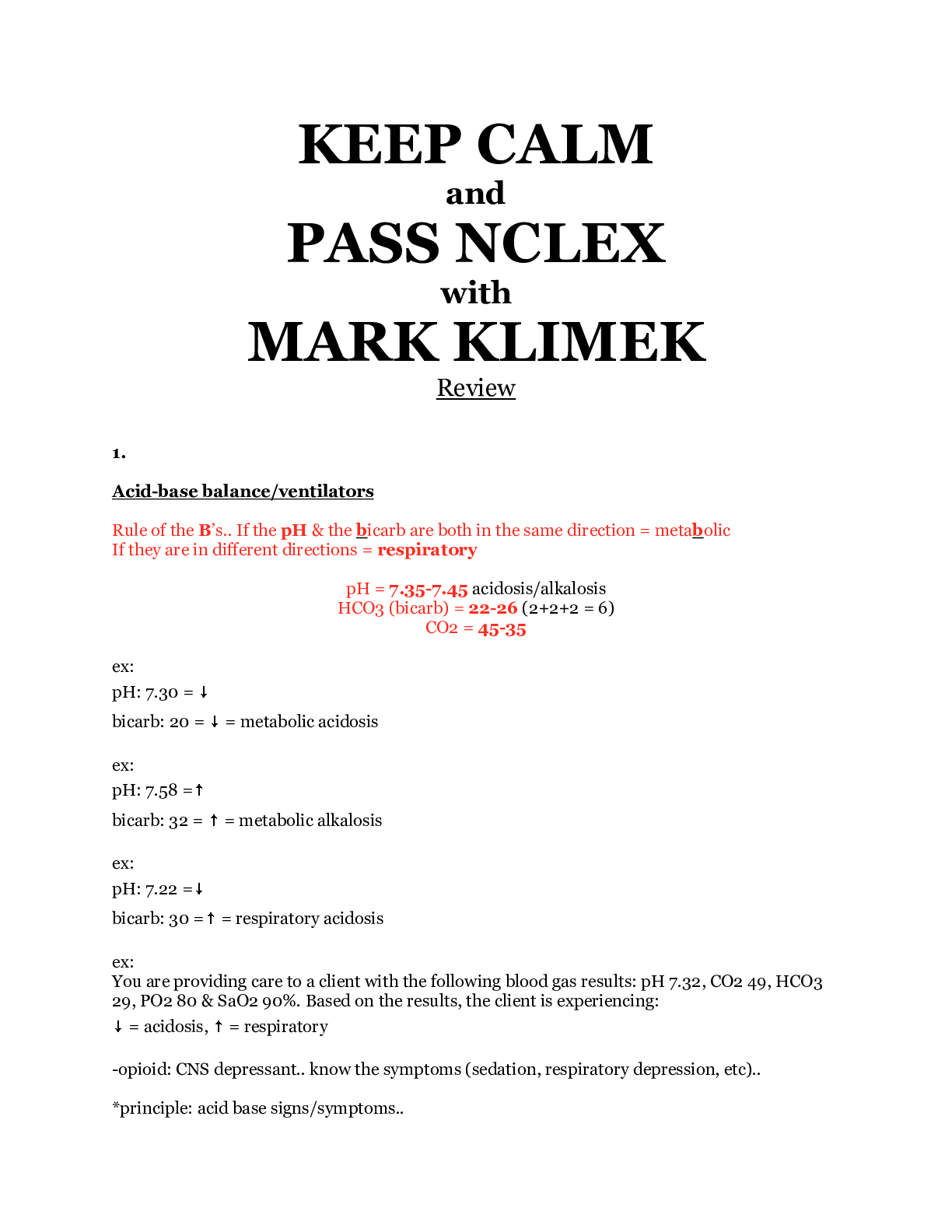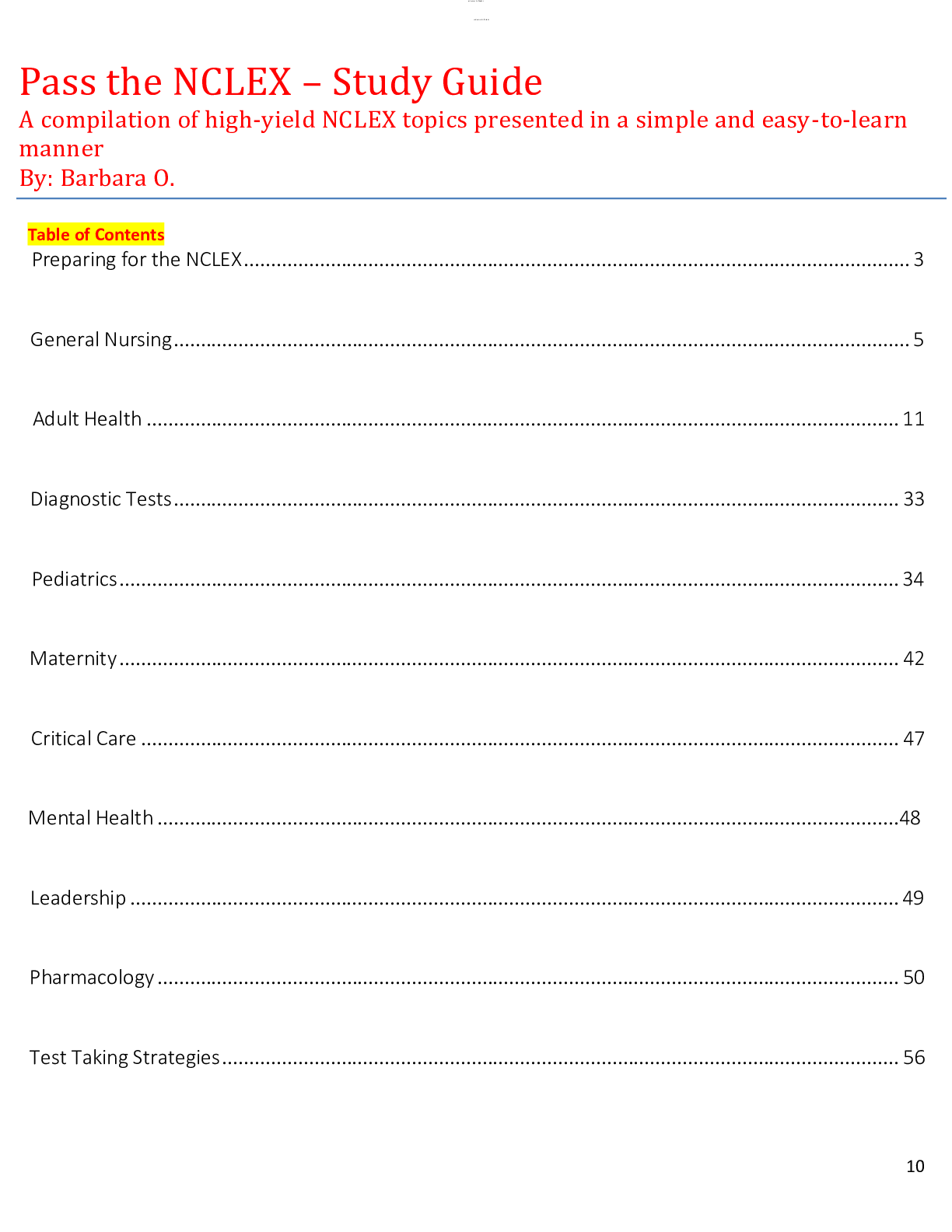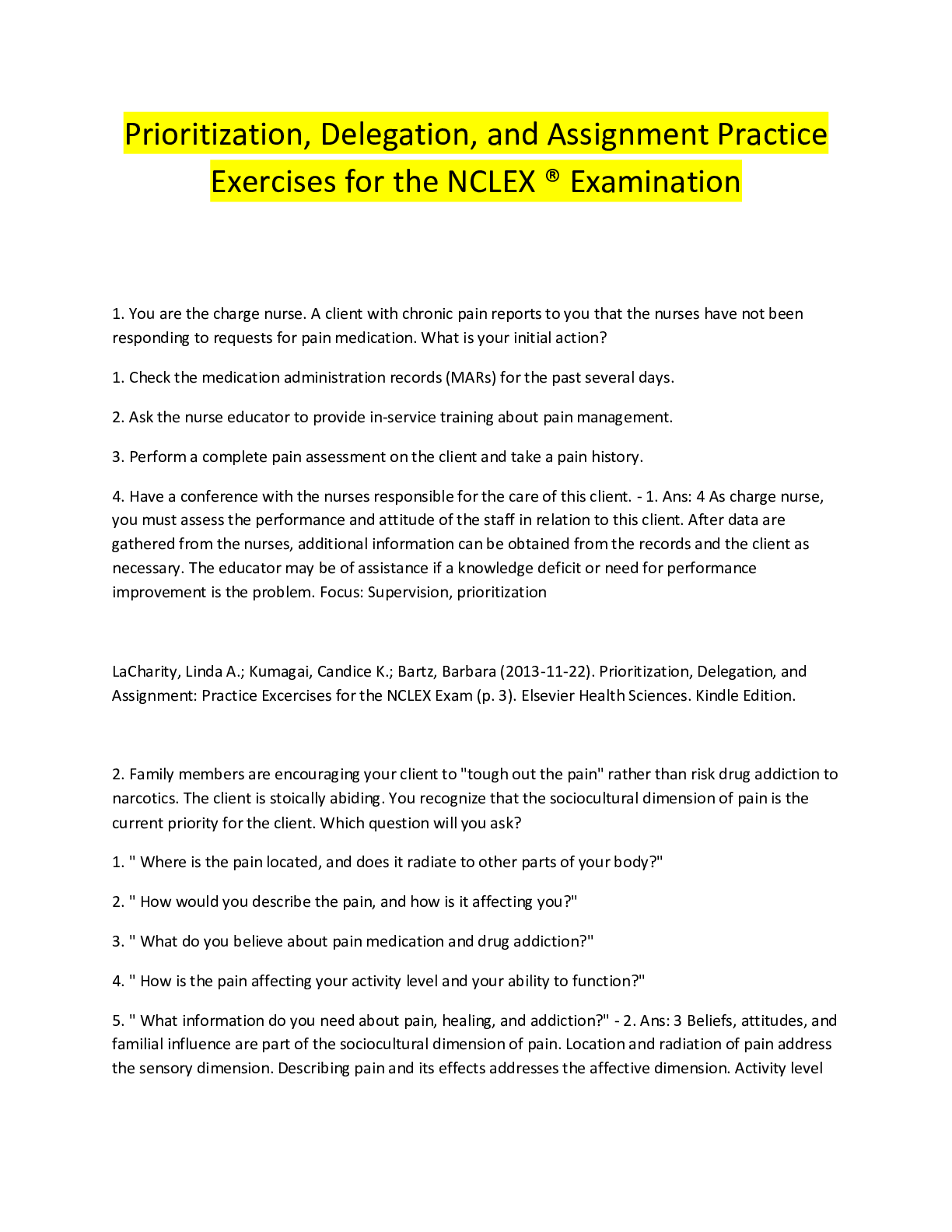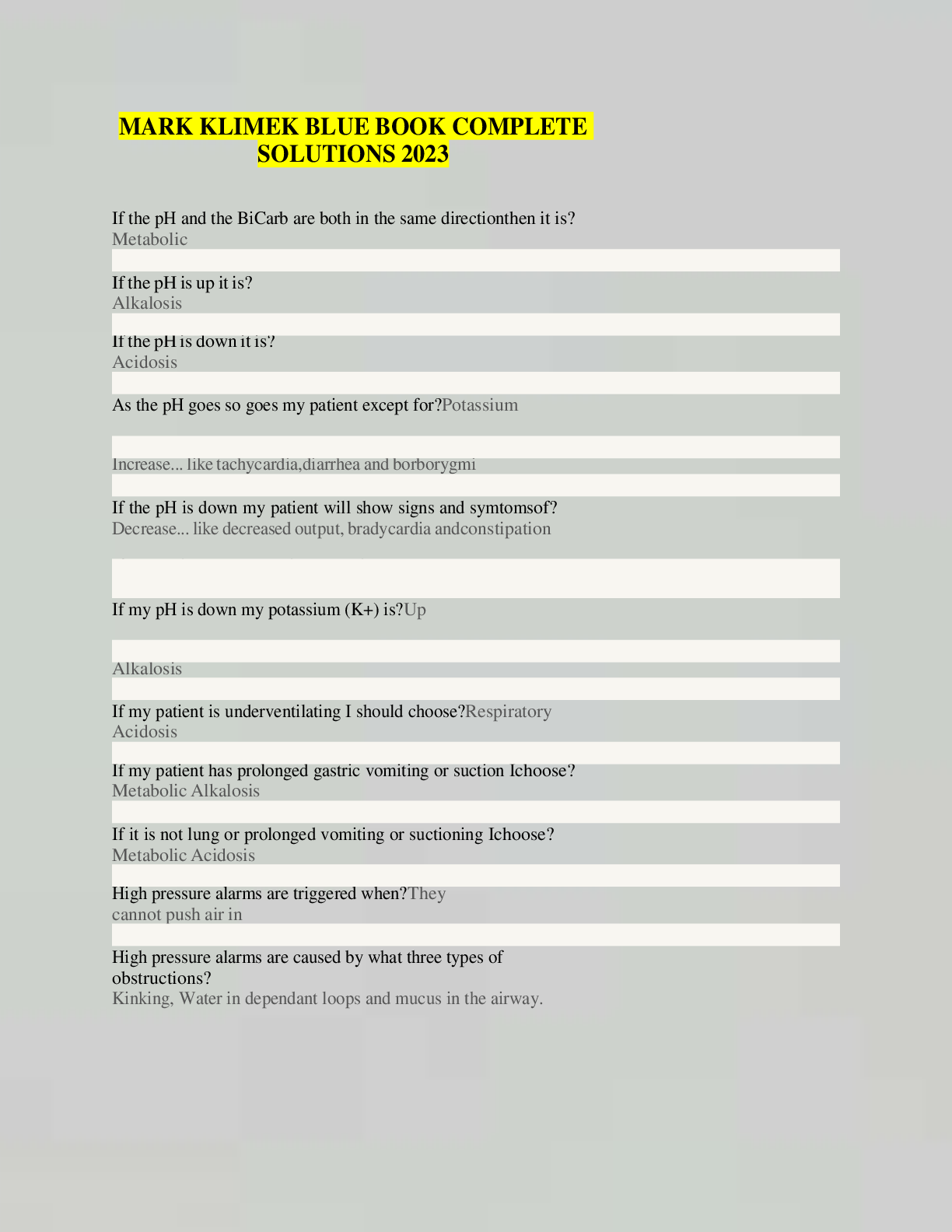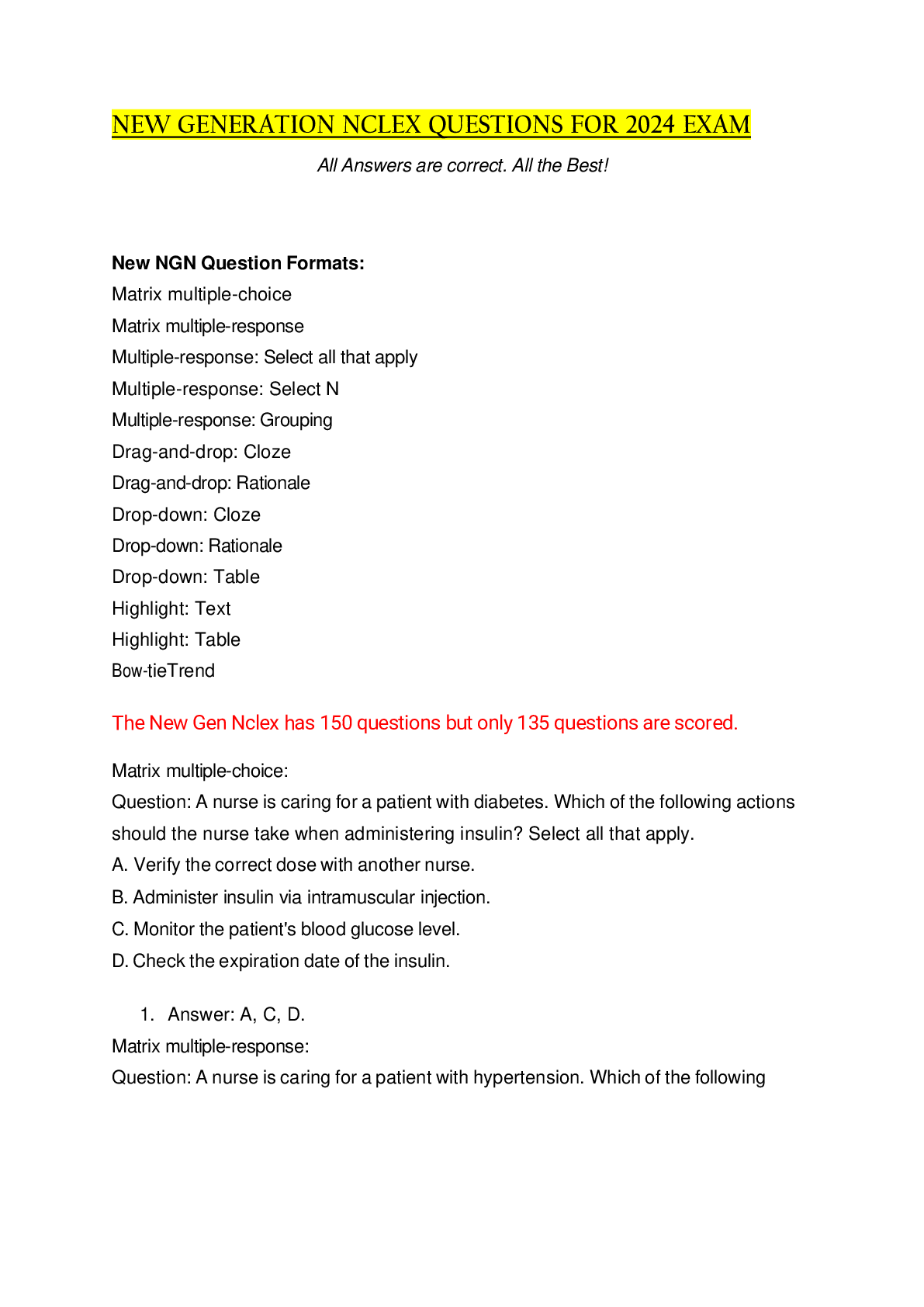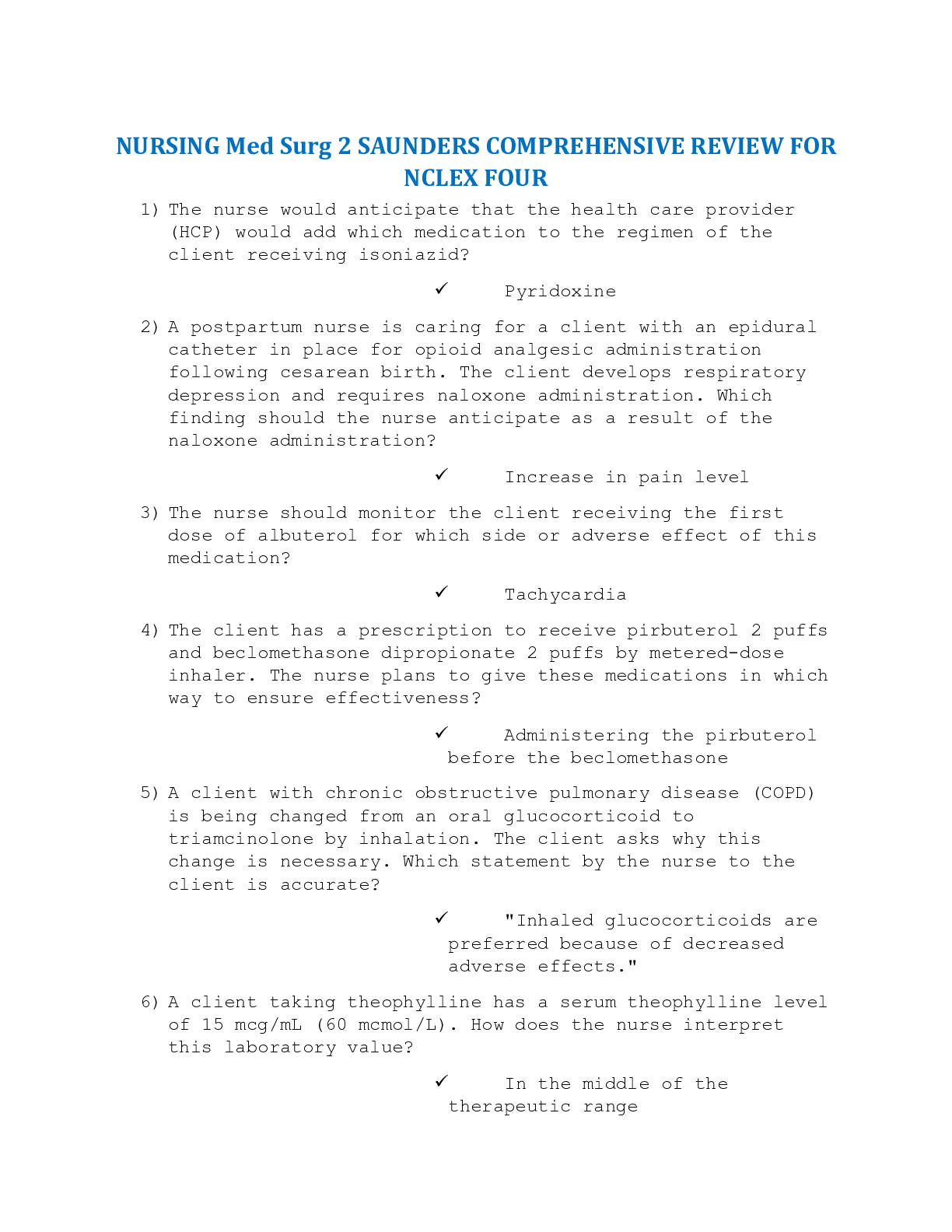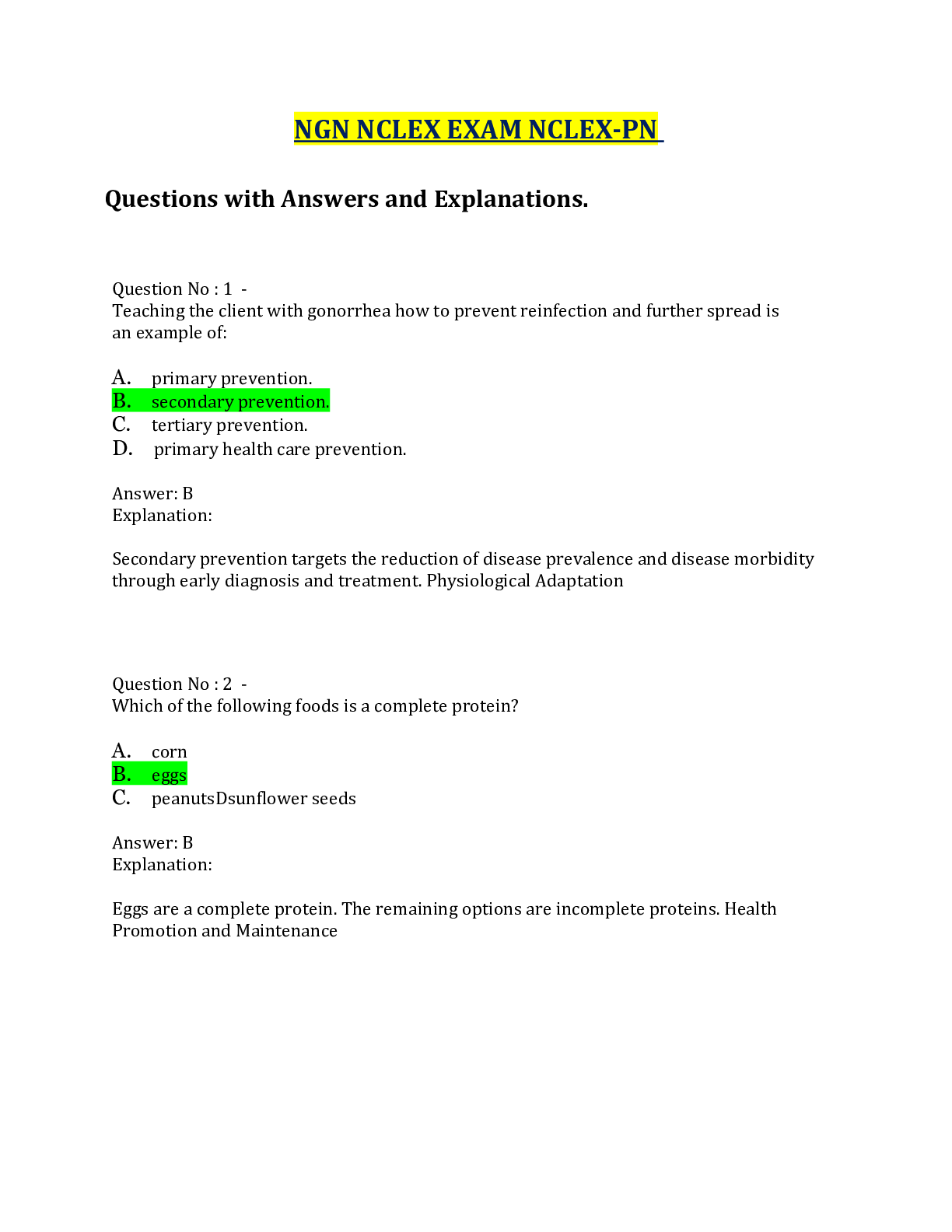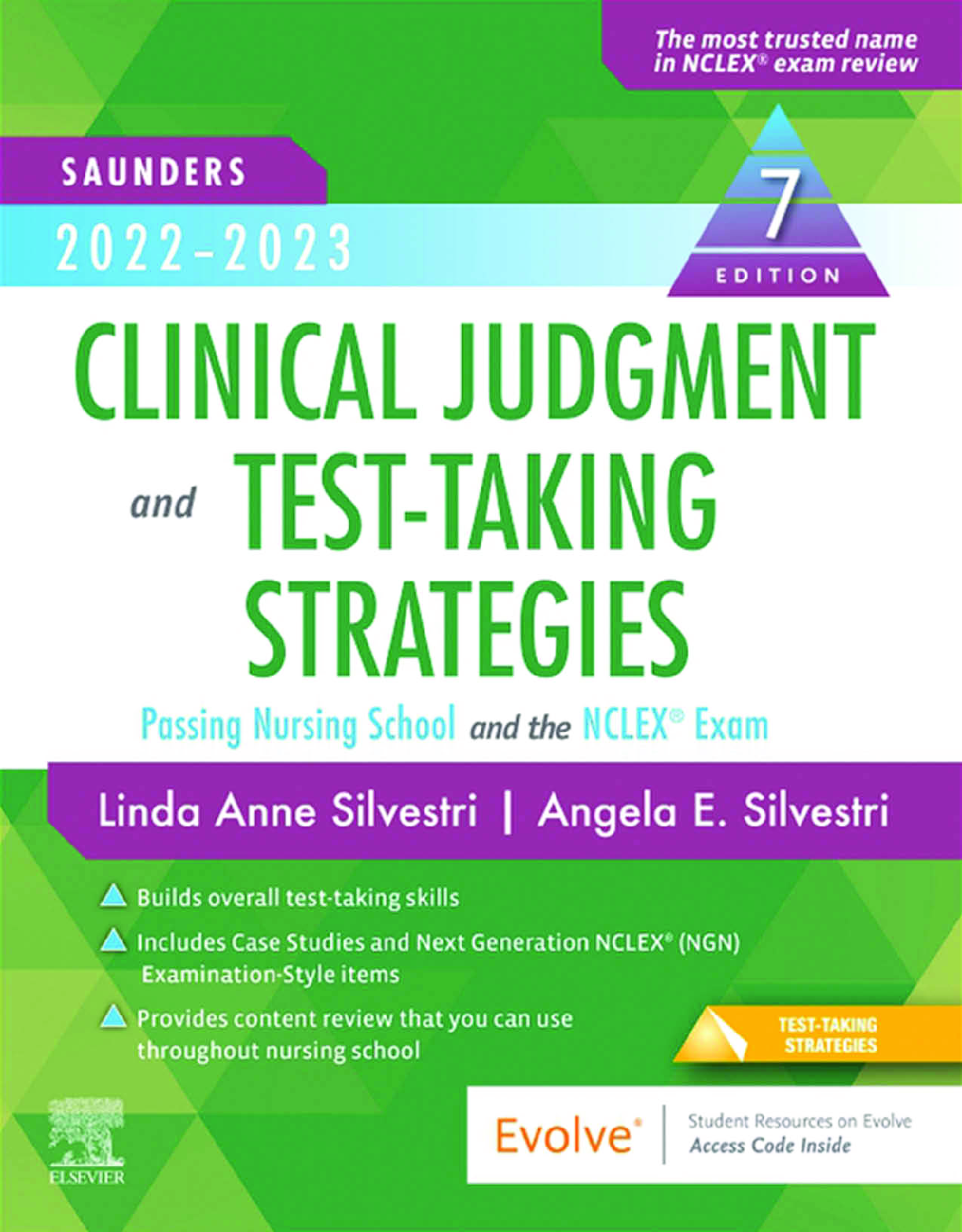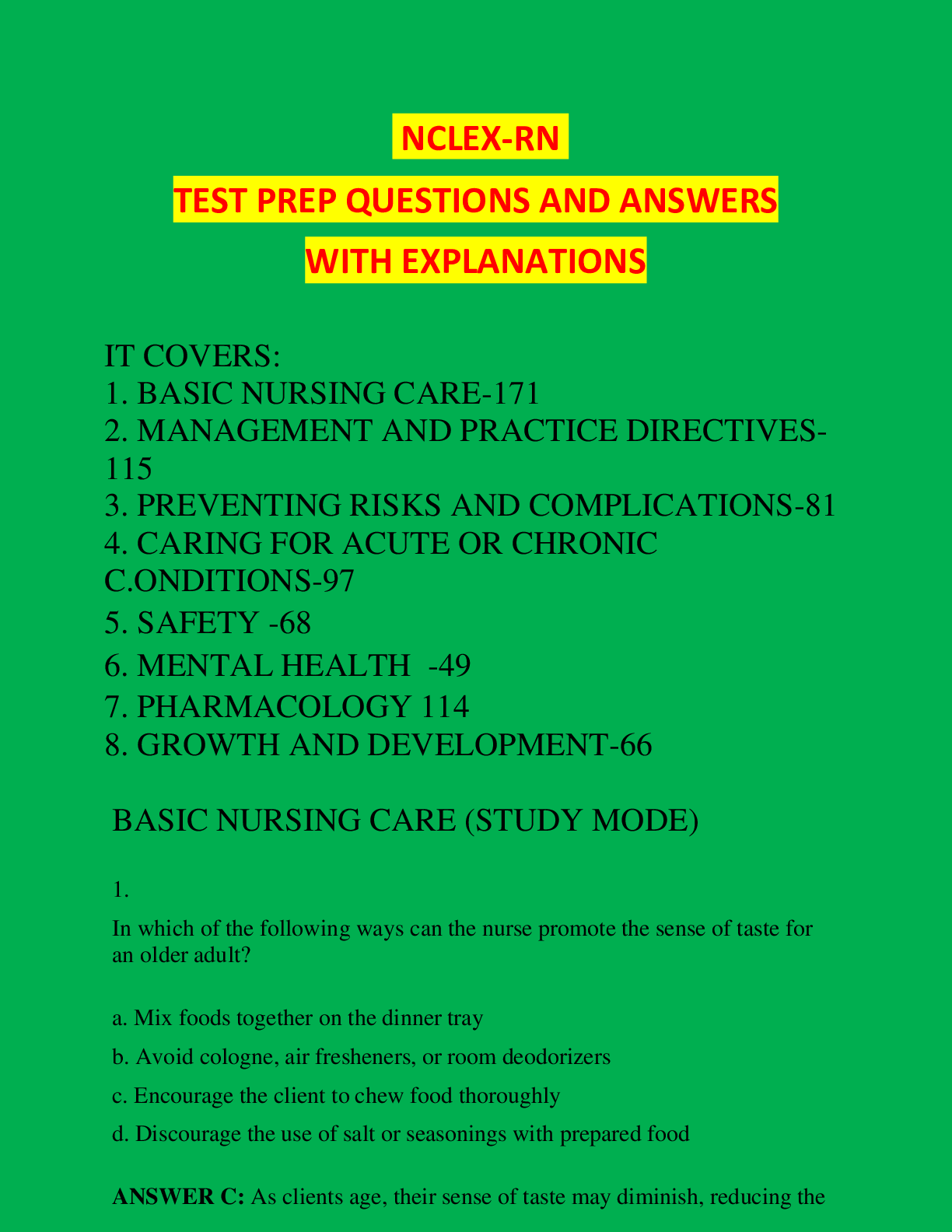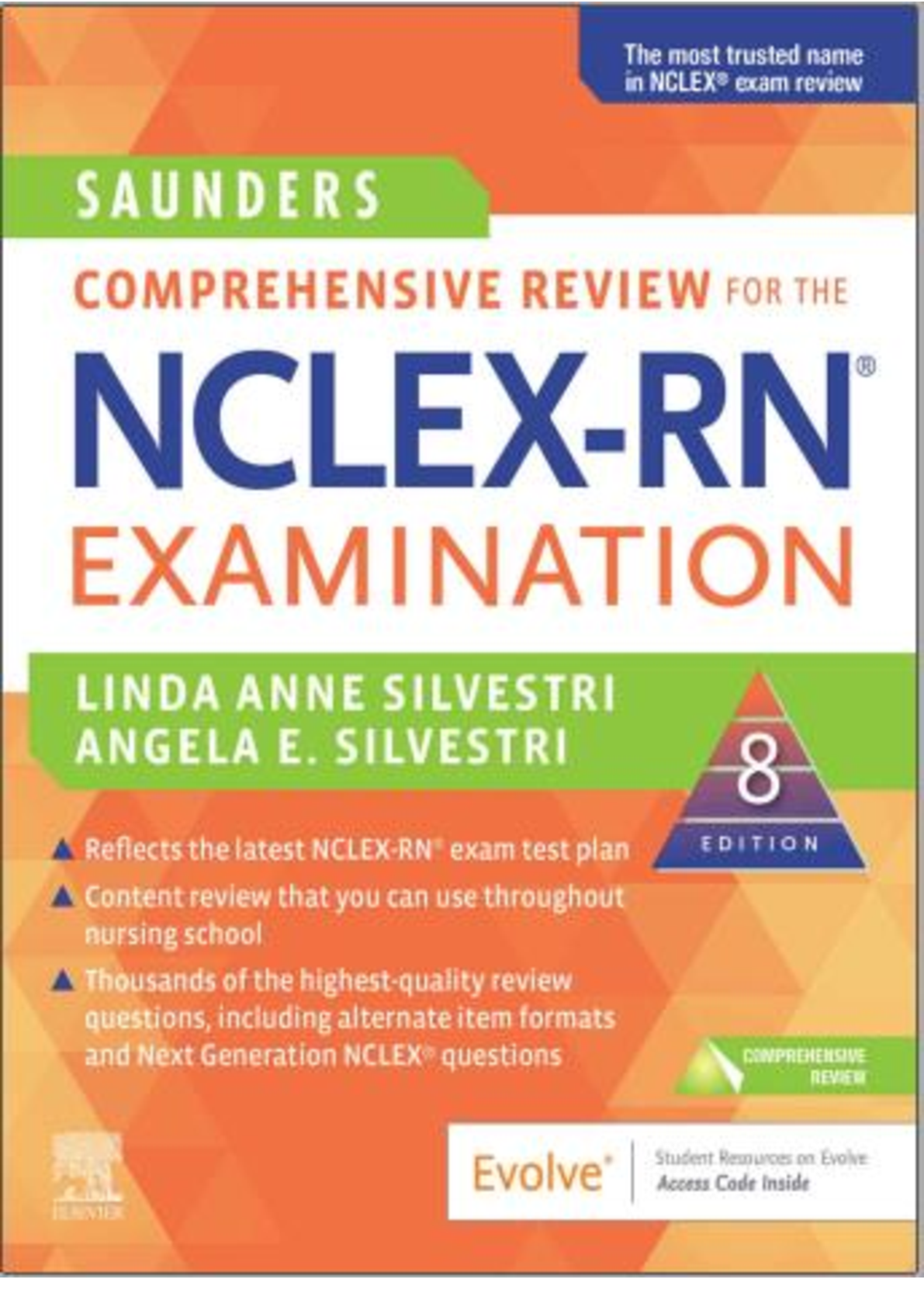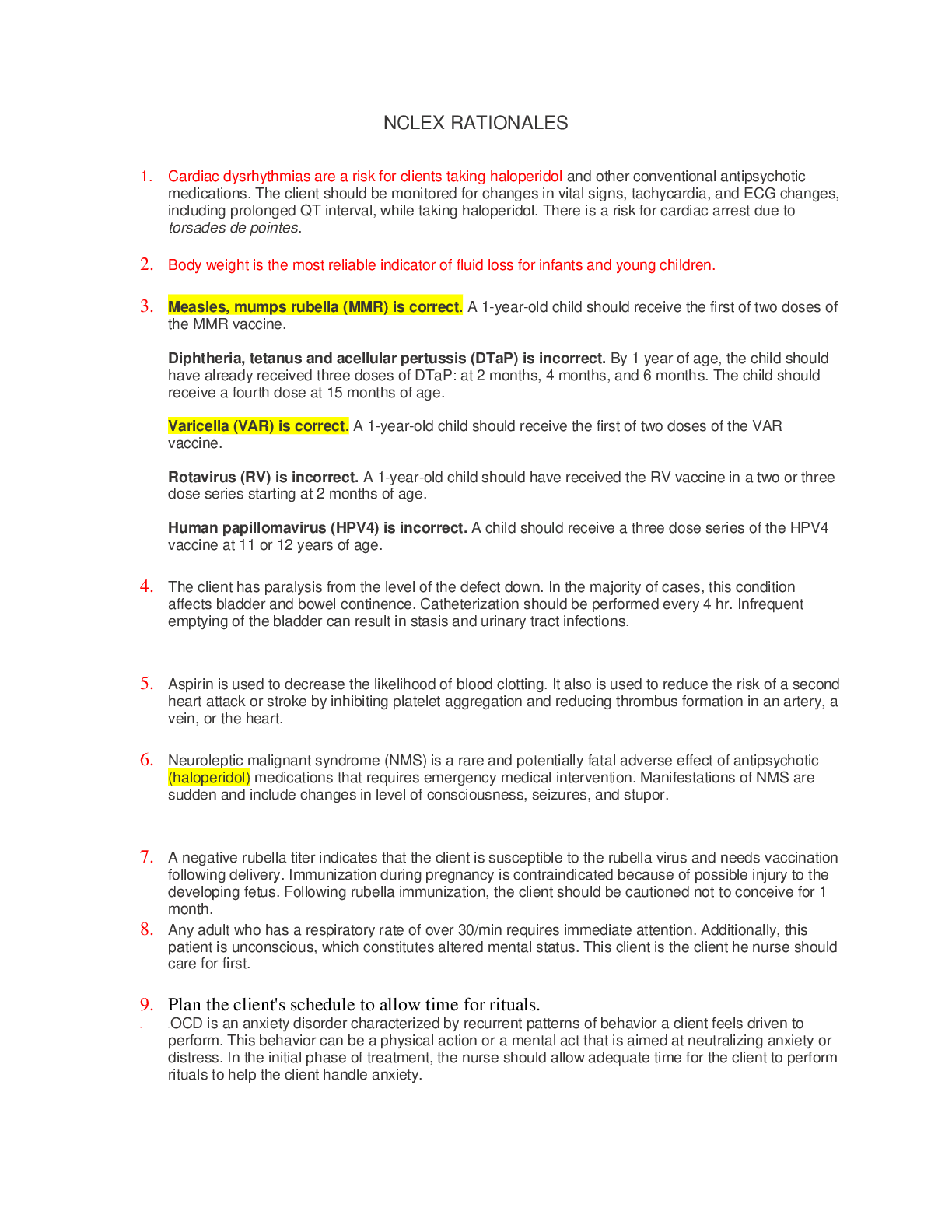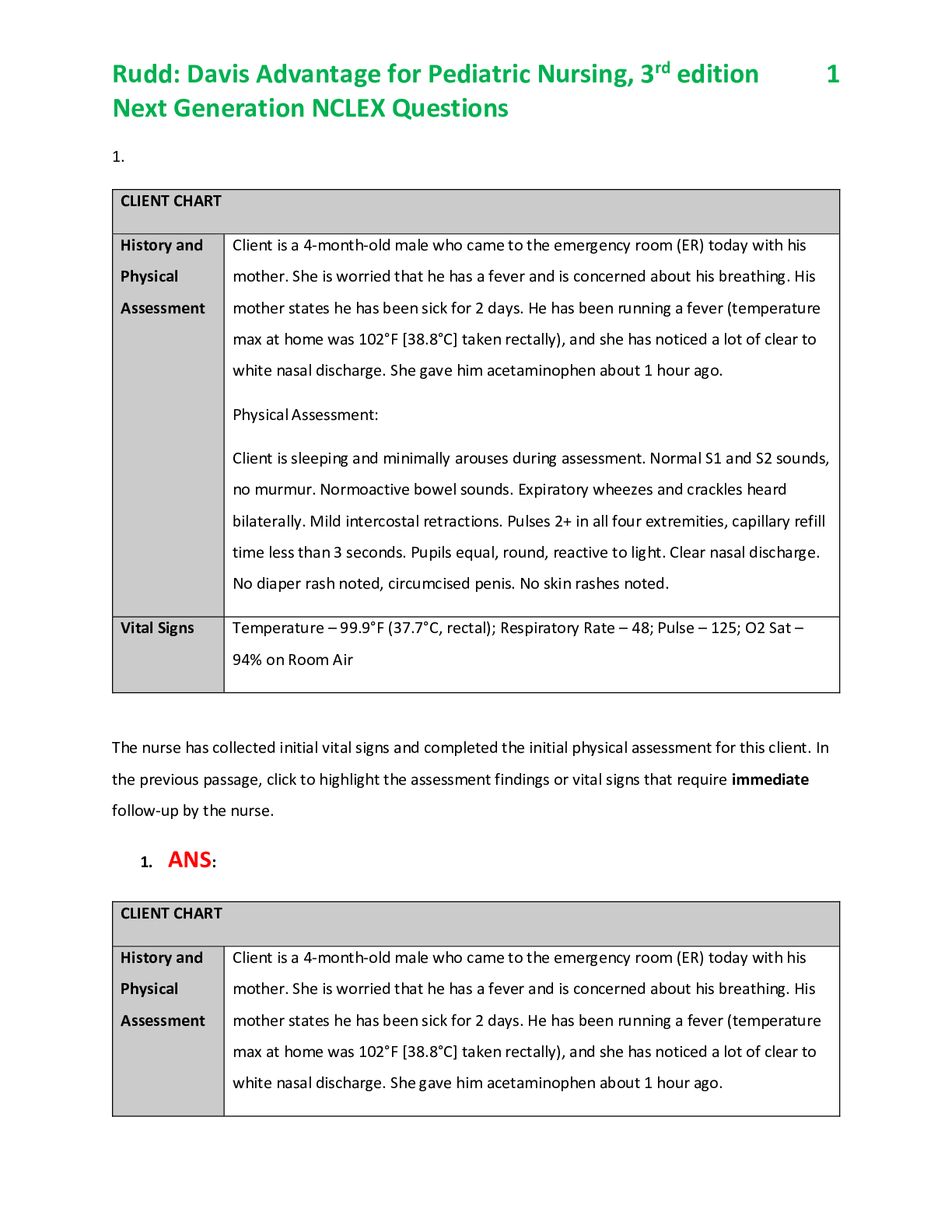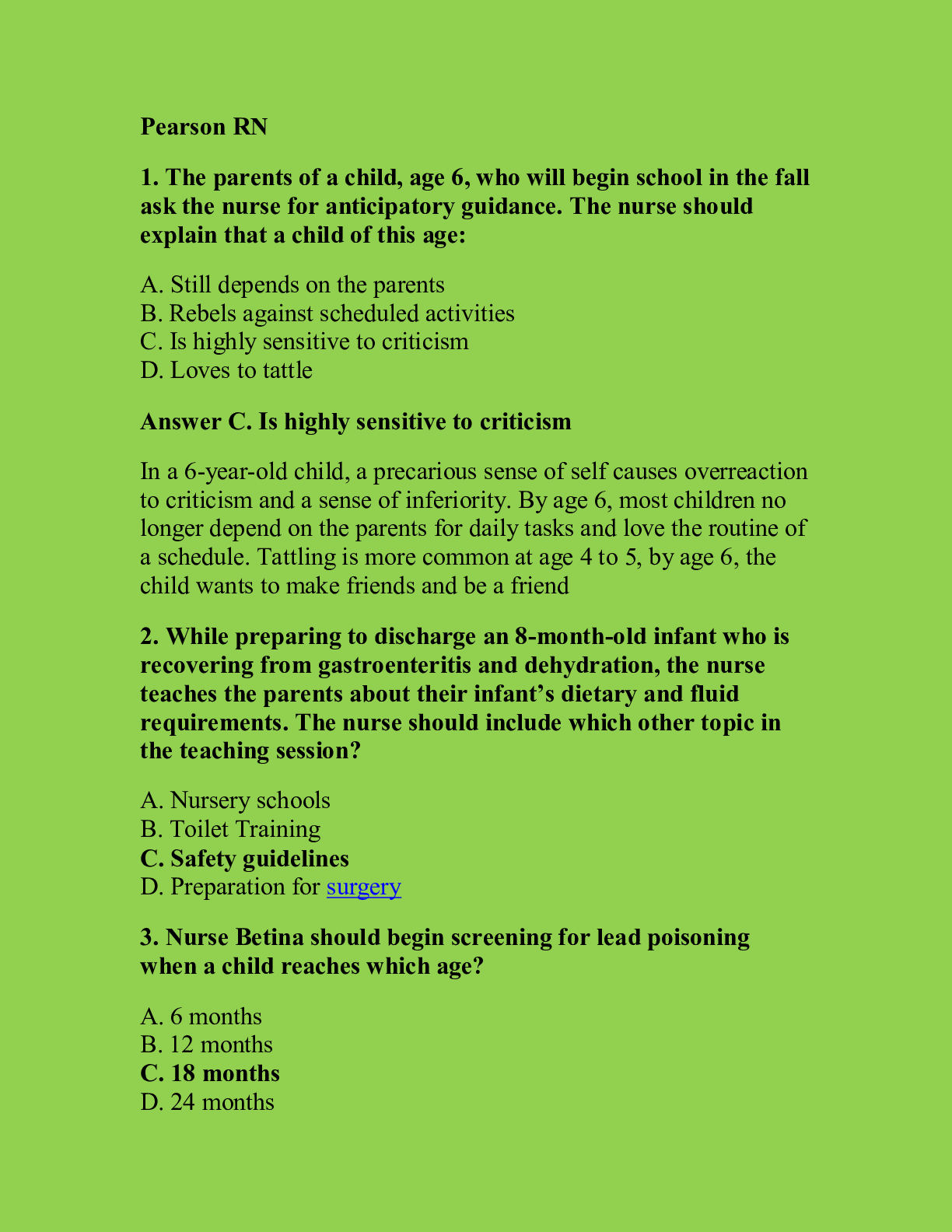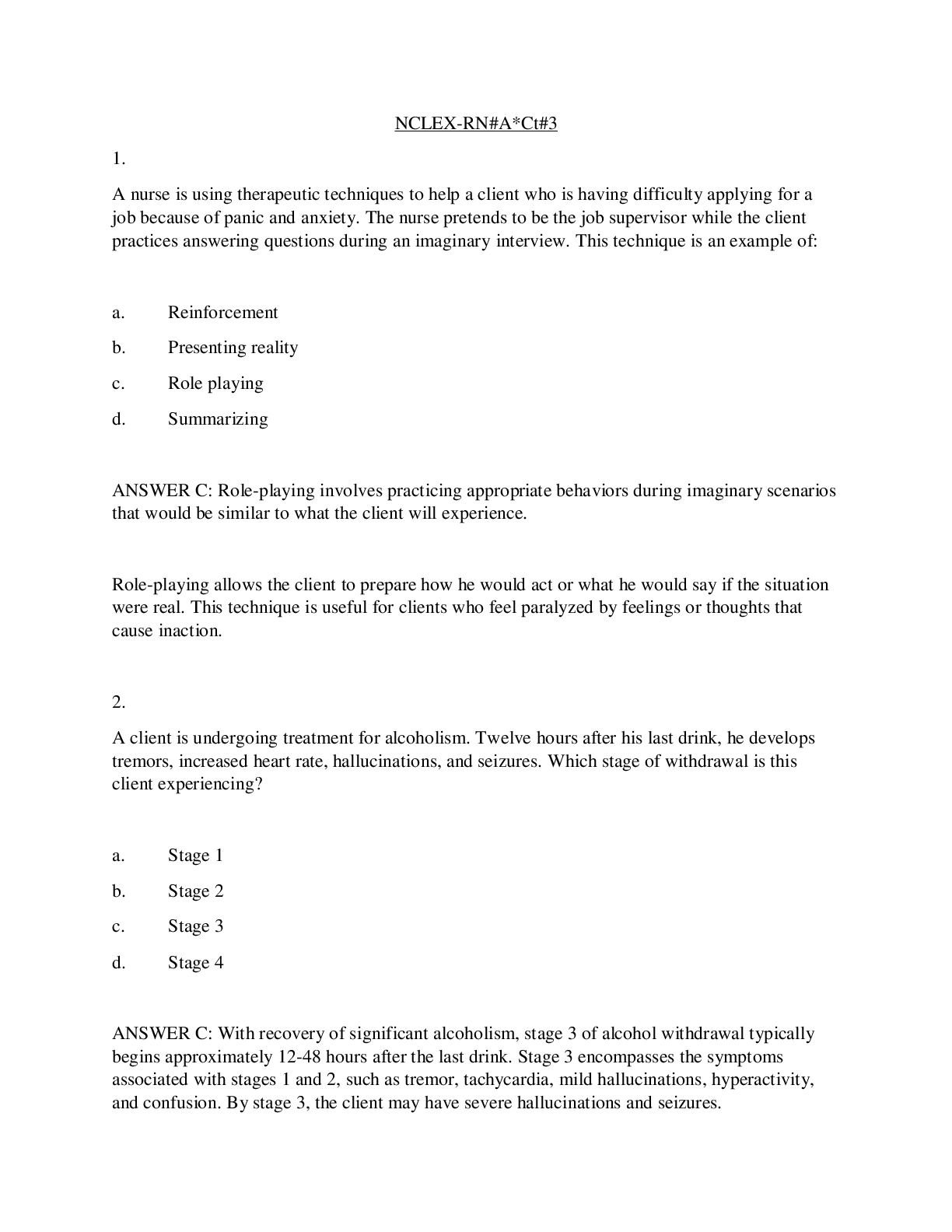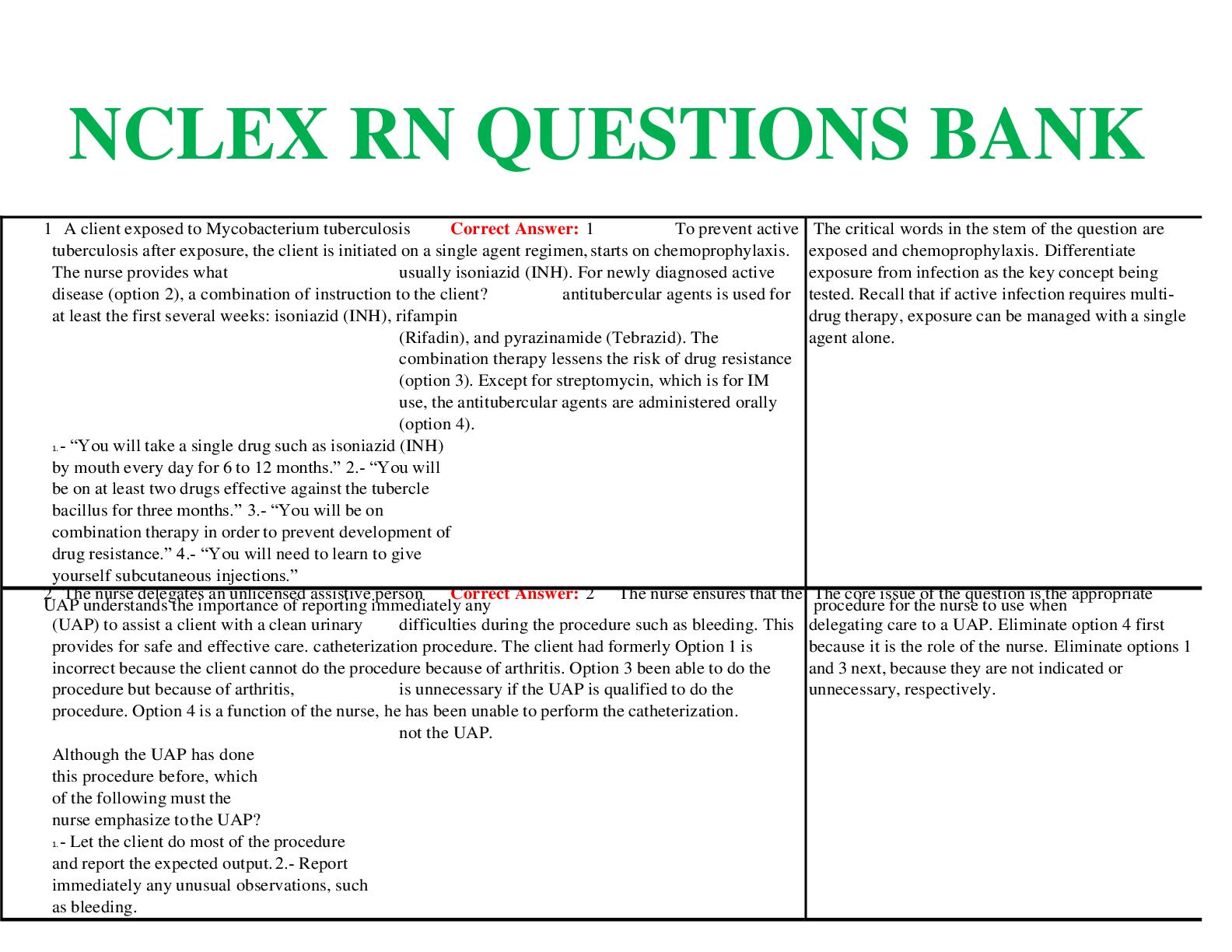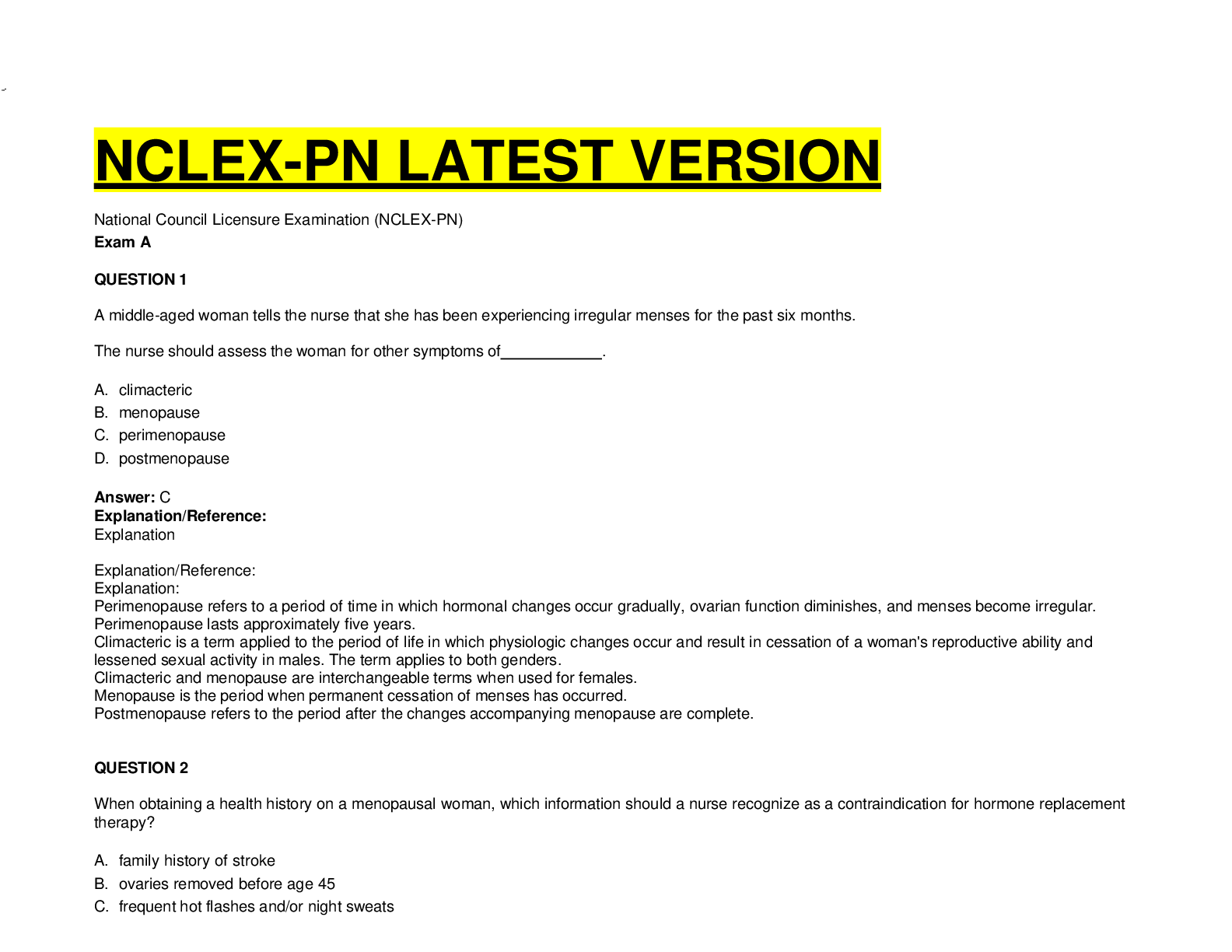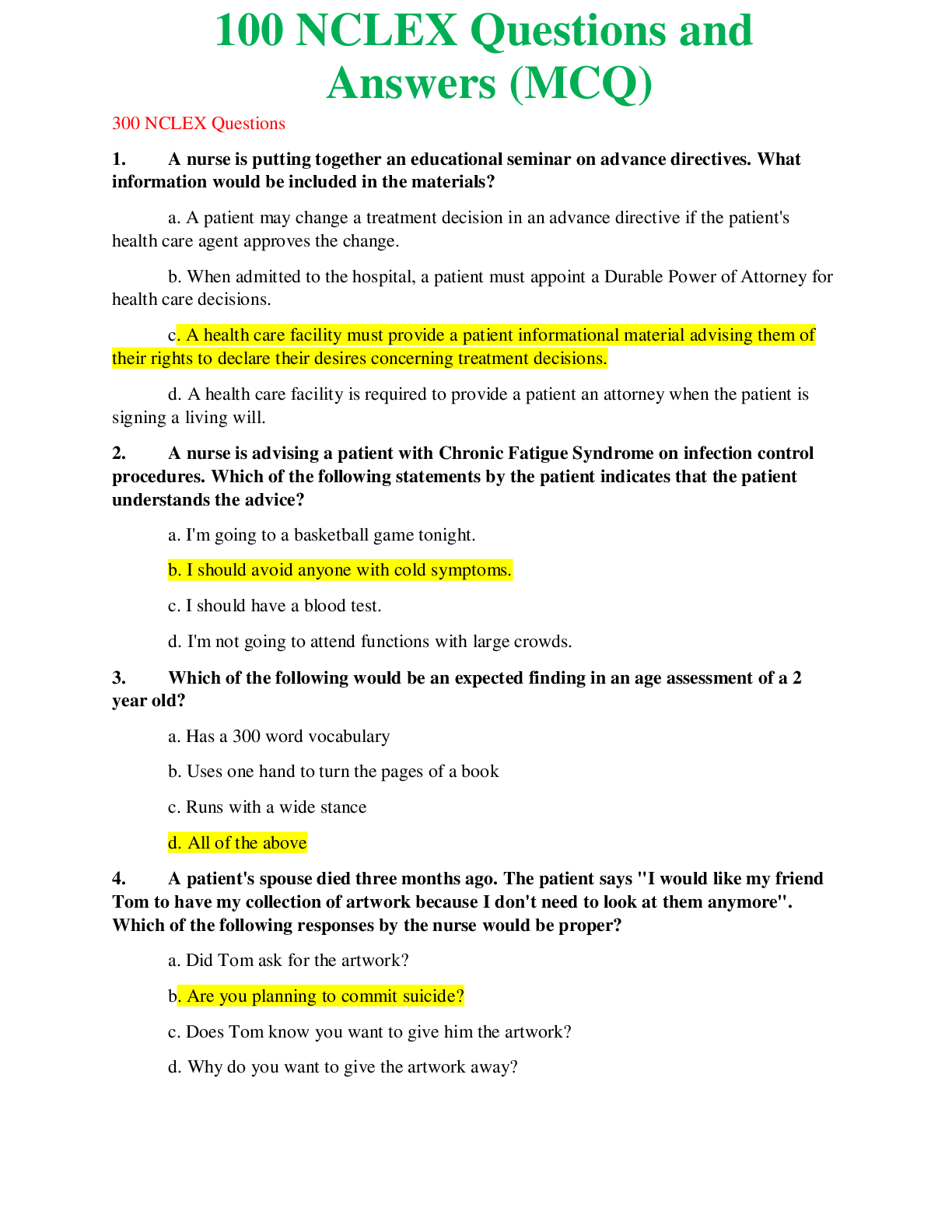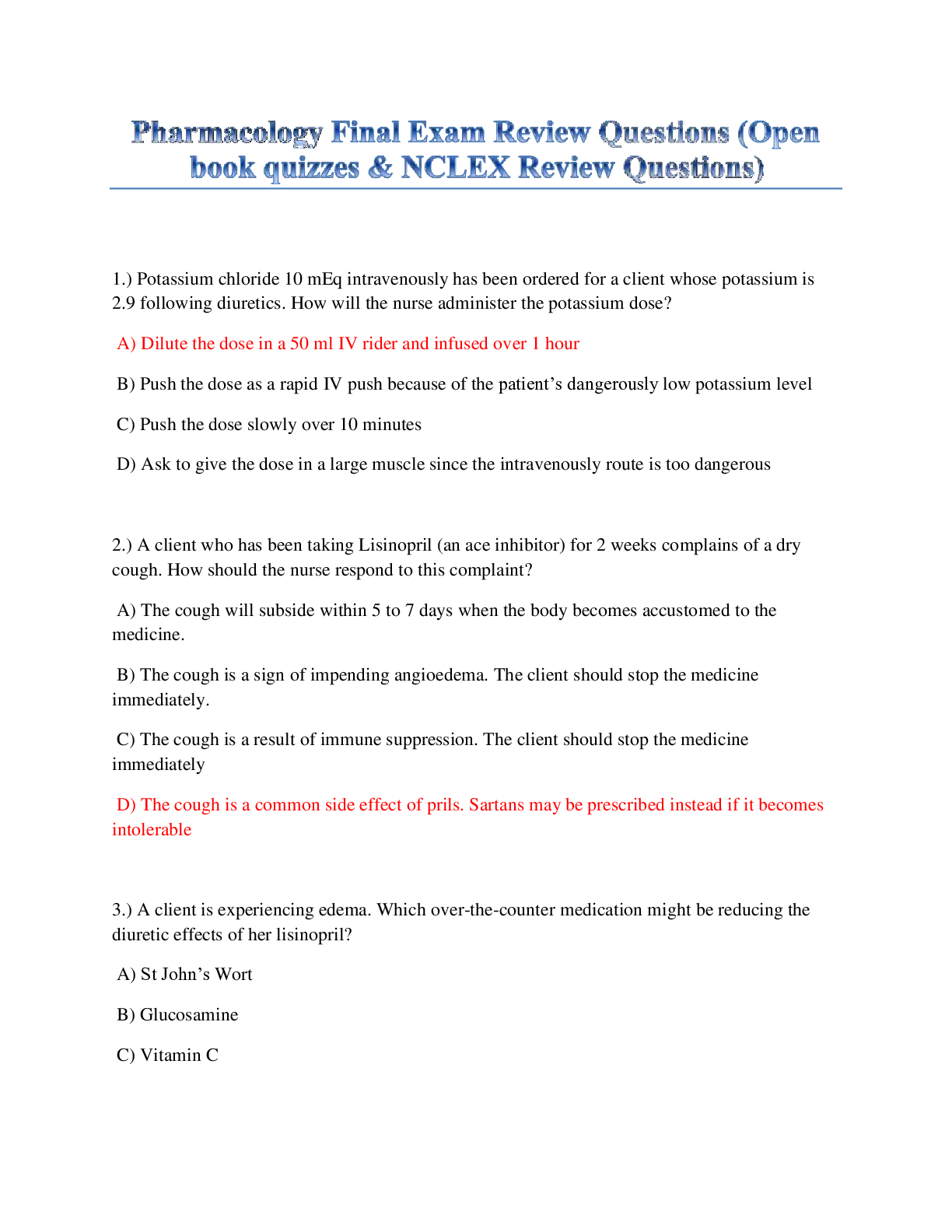*NURSING > NCLEX > NCLEX Community Health ATI questions and answers CHAPTER 1 TO CHAPTER 9 (EACH CHAPER 5 QUESTIONS) (All)
NCLEX Community Health ATI questions and answers CHAPTER 1 TO CHAPTER 9 (EACH CHAPER 5 QUESTIONS)
Document Content and Description Below
A nurse manager at a community agency is developing an orientation program for newly hired nurses. When discussing the differences between community-based and community-oriented nursing, the nurse sho... uld include which of the following situations as an example of community-based nursing? (Select all that apply.) A) A home health nurse performing wound care for a client who is immobile B) An occupational health nurse providing classes on body mechanics at a local industrial plant C) A school nurse teaching a student who has asthma about medications D) A parish nurse teaching a class on low-sodium cooking techniques E) A mental health nurse discussing stress management techniques with a support group F) 2. A nurse is advocating for local leaders to place a newly-approved community health clinic in an area of the city that has fewer resources than other areas. The nurse is advocating for the leaders to uphold which of the following ethical principles? A) Distributive justice B) Fidelity C) Respect for autonomy D) Veracity 3. A public health nurse is reviewing the outcomes of an exercise program at various locations. Which of the following aspects of care does this finding evaluate? A) Timeliness B) Client-centered C) Equity D) Safety 4. A public health nurse is planning several initiatives for a city. Which of the following interventions should the nurse include as part of public health assurance? A) Meeting with city officials to propose changes to health laws B) Partnering with a laboratory company to provide free HIV screenings for the public C) Reviewing data for incidence of influenza over a 25-year span D) Providing medical facilities with information accidental injury rates 5. A community health nurse is implementing health programs with several populations in the local area. In which of the following situations is the nurse using primary prevention? A) Performing a home safety check at a client’s home B) Teaching healthy nutrition to clients who have hypertension C) Providing influenza immunizations to employees at a local preschool D) Implementing a program to notify individuals exposed to a communicable diseasE A nurse is preparing an educational program on cultural perspectives in nursing. The nurse should include that which of the following factors are influenced by an individual’s culture? (Select all that apply.) A) Nutritional practices B) Family structure C) Health care interactions D) Biological variations E) Views about illness 2. A nurse is caring for a client who is from a different culture than the nurse. When beginning the cultural assessment, which of the following actions should the nurse take first? A) Determine the client’s perception of their current health status. B) Gather data about the client’s cultural beliefs. C) Determine how the client’s culture can affect the effectiveness of nursing actions. D) Gather information about previous client interactions with the health care system. 3. A nurse is using the I PREPARE mnemonic to assess a client’s potential environmental exposures. Which of the following questions should the nurse ask when assessing for “A” in the mnemonic? A) “What do you like to do for fun?” B) “What year was your residence built?” C) “What jobs have you had in the past?” D) “What industries are near where you live?” 4. A nurse is reviewing information about the local health department to prepare for an interview. Which of the following services should the nurse expect the local health department to provide? (Select all that apply.) A) Managing the Women, Infants, and Children program B) Providing education to achieve community health goals C) Coordinating directives from state personnel D) Reporting communicable diseases to the CDC E) Licensing Of Registered Nurses 5. A nurse is conducting health screenings at a statewide health fair and identifies several clients who require referral to a provider. Which of the following statements by a client indicates a barrier to accessing health care? A) “I don’t drive, and my son is only available to take me places in the mornings.” B) “I can’t take off during the day, and the local after-hours clinic is no longer in operation.” C) “Only one doctor in my town is a designated provider by my health maintenance organization.” D) “I would like to schedule an appointment with the local doctor in my town who speaks Spanish and ENGLISH A nurse is preparing an education program on disease transmission for employees at a local day care facility. When discussing the epidemiological triangle, the nurse should include which of the following factors as agents? (Select all that apply.) A. Resource availability B. Ethnicity C. Toxins D. Bacteria E. Alteredimmunity 2. A nurse is preparing a community health program on communicable diseases. When discussing modes of transmission, the nurse should include which of the following illnesses as airborne? A. Cholera B. Malaria C. Influenza D. Salmonellosis 3. A nurse is planning measures to reduce the incidence of obesity. Which of the following interventions affects the environment, according to the epidemiological triangle? A. Determine whether clients have a family history of obesity. B. Measure clients’ BMI. C. Provide low-fat meal options at public schools. D. Ask affected adults to keep a diary of food intake. 4. A nurse is reviewing data on the rates of varicella zoster (chicken pox) for a county. If there were 416 cases of varicella in one year among a population of 32,000 people, what should the nurse record as the incidence rate per 1,000 people? 5. A nurse is determining the attack rate following an E. coli outbreak at a restaurant. If 84 people ate contaminated lettuce, and 13 people developed an E. coli infection, what should the nurse conclude as the attack rate? A nurse is preparing to conduct a windshield survey. Which of the following data should the nurse collect as a component of this assessment? (Select all that apply.) A) Ethnicity of community members B) Individuals who hold power within the community C) Natural community boundaries D) Prevalence of disease E) Presence of public protection 2. A nurse is completing a needs assessment and beginning analysis of data. Which of the following actions should the nurse take first? A) Determine health patterns within collected data. B) Compile collected data into a database. C) Ensure data collection is complete. D) Identify health needs of the local community. 3. A nurse is planning a community health program. Which of the following actions should the nurse include as part of the evaluation plan? A) Determine availability of resources to initiate the plan. B) Gain approval for the program from local leaders. C) Establish a timeline for implementation of interventions. D) Compare program impact to similar programs. 4. A nurse is conducting a community assessment. Which of the following data collection methods is the nurse using when having direct conversations with individual members of the community? A) Key informant interviews B) Participant observation C) Focus groups D) Health surveys 5. A nurse is collecting data to identify health needs in the local community. Which of the following examples should the nurse identify as secondary data? (Select all that apply.) A nurse is talking to a client who asks for additional information about hospice. Which of the following statements should the nurse make? A) “Clients who require skilled nursing care at home qualify for hospice care.” B) “One function of hospice is to provide teaching to clients about life-sustaining measures.” C) “Hospice assists clients to develop the skills needed to care for themselves independently.” D) “A component of hospice care is to control the client’s manifestations.” 2. A school nurse is scheduling visits with a physical therapist for a child who has cerebral palsy. In which of the following roles is the nurse functioning? A) Direct caregiver B) Consultant C) Case manager D) Counselor 3. An occupational health nurse is consulting with senior management of a local industrial facility. When discussing work-related illness and injury, the nurse should include which of the following factors as physical agents? (Select all that apply.) A) Noise B) Age C) Lighting D) Viruses E) Stress 4. A newly hired occupational health nurse at an industrial facility is performing an initial workplace assessment. Which of the following information should the nurse determine when conducting a work site survey? A) Work practices of employees B) Past exposure to specific agents C) Past jobs of individual employees D) Length of time working in current role 5. A school nurse is planning health promotion and disease prevention activities for the upcoming school year. In which of the following situations is the nurse planning a secondary prevention strategy? A) Placing posters with images of appropriate hand hygiene near restrooms B) Routinely checking students for pediculosis throughout the school year C) Implementing age-appropriate injury prevention programs for each grade level D) Working with a dietitian to determine carbohydrate counts for students who have diabetes mellitus A nurse is completing an ecomap as part of a family assessment. Which of the following questions should the nurse plan to ask to gather appropriate data? A) “Do you have a family history of heart disease?” B) “What kinds of foods does your family eat?” C) “Is your family involved in any community organizations?” D) “How does your family cultural beliefs influence your health values?” 2. A home health nurse is planning care for a client following a stroke. The nurse plans to interview each member of the family to see how they might help the client progress towards recovery. The nurse is using which of the following approaches to family health? A) Family as a component of society B) Family as a system C) Family as a client D) Family as context 3. A public health nurse is planning interventions for children in the community. Which of the following topics should the nurse choose to target a major concern for school-aged children? A) Skin cancer detection B) Access to healthcare C) STI prevention D) Cholesterol screening 4. A public health nurse is planning an in-service on older adult health. Which of the following information should the nurse include? A) The percentage of older adults in the population is decreasing. B) The proportion of older adults who live alone is increasing. C) Older adults take one-half of all prescription medications. D) Older adults have a decreased recovery time following injury. 5. A nurse is preparing a list of important topics to discuss with young adults who are seen at the clinic. Which of the following topics should the nurse plan to address with this aggregate? A) Preconception counseling B) Managing the common cold C) Detecting congenital abnormalities D) Accessing Medicare benefits A nurse at a community clinic is conducting a well-child visit with a preschool-age child. The nurse should identify which of the following manifestations as a possible indication of child neglect? (Select all that apply.) A) Underweight B) Healing spiral fracture of the arm C) Genital irritation D) Burns on the palms of the hands E) Poorhygiene 2. A nurse is planning interventions for migrant farm workers in a rural area. Which of the following should the nurse include as part of primary prevention? A) Establish food banks at locations throughout the community. B) Provide employers handouts on recognizing pesticide toxicity. C) Partner with clinics to provide on- site care for acute injuries. D) Create handouts on identifying skin cancer in multiple languages. 3. A community health nurse is developing an education program on substance use disorders for a group of adolescents. Which of the following information should the nurse include when discussing nicotine and smoking? A) Smoking is the fifth-most preventable cause of death in the United States. B) Nicotine is a central nervous system depressant. C) Withdrawal effects from smoking are minimal. D) Tolerance to nicotine develops quickly. 4. A community health nurse is developing strategies to prevent or improve mental health issues in the local area. In which of the following situations is the nurse implementing a tertiary prevention strategy? A) Providing support programs for new parents B) Screening a client whose partner recently died for suicide risk C) Teaching a client who has schizophrenia about medication interactions D) Discussing stress reduction techniques with employees at an industrial site 5. A nurse at an urban community health agency is developing an education program for city leaders about homelessness. Which of the following groups should the nurse include as the fastest-growing segment of the homeless population? A) Families with children B) Adolescent runaways C) Individuals who have experienced spouse or partner violence A nurse is interviewing a group of people several weeks after a community tornado. Which of the following statements by a group member should the nurse identify as the emotional reaction of reconstruction? (Select all that apply.) A) “I am tired and don’t think I’ll ever be able to fix everything.” B) “I can’t believe we survived. I keep telling everyone what happened.” C) “Things will never be the same, but we will find a way to go on.” D) “Our neighborhood is working together to make good changes.” E) “My old hobbies don’t seem interesting anymore since the tornado.” 2. A nurse is preparing a presentation on bioterrorism. Which of the following findings should the nurse include as an indication of potential bioterrorism? A) Nationwide incidence of pneumonia is higher than the prior year. B) A large number of otherwise healthy adults are dying from sepsis. C) A health department reports cases of influenza in October. D) Most of the clients’ diagnoses with pneumonia have an elevated white blood cell count. 3. A newly hired public health nurse is reviewing the disaster management cycle. Which of the following actions is a component of disaster prevention? A) Outlining specific roles of community agencies B) Identifying community vulnerabilities C) Prioritizing care of individual D) Providing stress counseling 4. A community health nurse is educating the public on the agents of bioterrorism. Which of the following agents should the nurse include as Category biological agents? (Select all that apply.) A) Hantavirus B) Typhus C) Plague D) Tularemia E) Botulism 5. A community health nurse is determining available and needed supplies in the event of a bioterrorism attack. The nurse should be aware that community members exposed to anthrax will need access to which of the following medications? A) Metronidazole B) Ciprofloxacin C) Zanamivir D) Fluconazole [Show More]
Last updated: 1 year ago
Preview 1 out of 18 pages
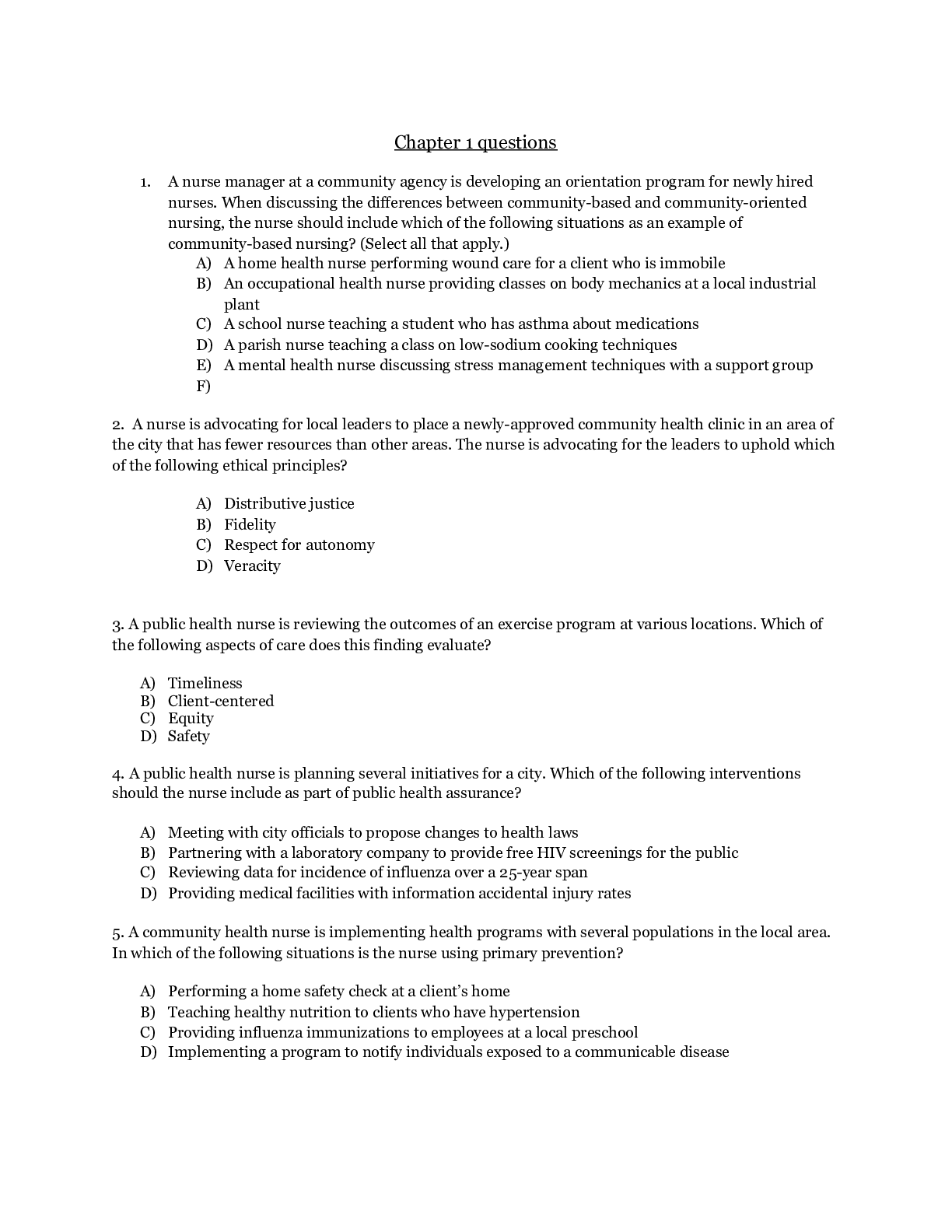
Reviews( 0 )
Document information
Connected school, study & course
About the document
Uploaded On
May 03, 2021
Number of pages
18
Written in
Additional information
This document has been written for:
Uploaded
May 03, 2021
Downloads
0
Views
120

